Publications
Selected Publications
Biomaterials
Supramolecular Copolymers of Peptides and Lipidated Peptides and Their Therapeutic Potential
Qiu, R.; Sasselli, I. R.; Álvarez, Z.; Sai, H.; Ji, W.; Palmer, L. C.; Stupp, S. I. “Supramolecular Copolymers of Peptides and Lipidated Peptides and their Therapeutic Potential” Journal of the American Chemical Society 2022, 144 (12) 5532-5574.
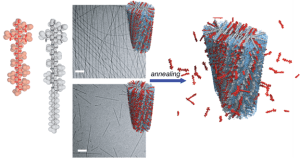
Supramolecular peptide chemistry offers a versatile strategy to create chemical systems useful as new biomaterials with potential to deliver nearly 1000 known candidate peptide therapeutics or integrate other types of bioactivity. We report here on the co-assembly of lipidated β-sheet-forming peptides with soluble short peptides, yielding supramolecular copolymers with various degrees of internal order. At low peptide concentrations, the co-monomer is protected by lodging within internal aqueous compartments and stabilizing internal β-sheets formed by the lipidated peptides. At higher concentrations, the peptide copolymerizes with the lipidated peptide and disrupts the β-sheet secondary structure. The thermodynamic metastability of the co-assembly in turn leads to the spontaneous release of peptide monomers and thus serves as a potential mechanism for drug delivery. We demonstrated the function of these supramolecular systems using a drug candidate for Alzheimer’s disease and found that the copolymers enhance neuronal cell viability when the soluble peptide is released from the assemblies.
Bioactive Scaffolds with Enhanced Supramolecular Motion Promote Recovery from Spinal Cord Injury
Álvarez, Z.; Kolberg-Edelbrock, A.N; Sasselli, I.R.; Ortega, J.A.; Qiu, R.; Syrgiannis, Z.; Mirau, P.A.; Cheng, F.; Chin, S.M.; Weigand, S.; Kiskinis, E.; Stupp, S.I. “Bioactive Scaffolds with Enhanced Supramolecular Motion Promote Recovery from Spinal Cord Injury” Science 2021, 374 (6569), 848-856.
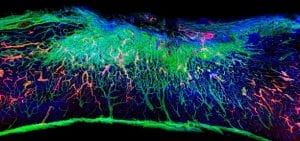
The signaling of cells by scaffolds of synthetic molecules that mimic proteins is known to be effective in the regeneration of tissues. Here, we describe peptide amphiphile supramolecular polymers containing two distinct signals and test them in a mouse model of severe spinal cord injury. One signal activates the transmembrane receptor β1-integrin and a second one activates the basic fibroblast growth factor 2 receptor. By mutating the peptide sequence of the amphiphilic monomers in nonbioactive domains, we intensified the motions of molecules within scaffold fibrils. This resulted in notable differences in vascular growth, axonal regeneration, myelination, survival of motor neurons, reduced gliosis, and functional recovery. We hypothesize that the signaling of cells by ensembles of molecules could be optimized by tuning their internal motions.
Reversible Self-Assembly of Superstructured Networks
Freeman, R.; Han, M.; Álvarez, Z.; Lewis, J. A.; Wester, J. R.; Stephanopoulos, N.; McClendon, M. T.; Lynsky, C.; Godbe, J. M.; Sangji, H.; Luijten E.; Stupp, S. I. “Reversible Self-Assembly of Superstructured Networks” Science 2018, 362 (6416), 808-813.
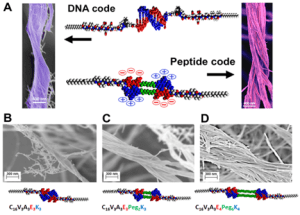
Soft structures in nature, such as protein assemblies, can organize reversibly into functional and often hierarchical architectures through noncovalent interactions. Molecularly encoding this dynamic capability in synthetic materials has remained an elusive goal. We report on hydrogels of peptide-DNA conjugates and peptides that organize into superstructures of intertwined filaments that disassemble upon the addition of molecules or changes in charge density. Experiments and simulations demonstrate that this response requires large-scale spatial redistribution of molecules directed by strong noncovalent interactions among them. Simulations also suggest that the chemically reversible structures can only occur within a limited range of supramolecular cohesive energies. Storage moduli of the hydrogels change reversibly as superstructures form and disappear, as does the phenotype of neural cells in contact with these materials.
Cell Death Versus Cell Survival Instructed by Supramolecular Cohesion of Nanostructures
Newcomb, C. J.; Sur, S.; Ortony, J. H.; Lee, O-S.; Matson, J. B.; Boekhoven, J.; Yu, J-M.; Schatz, G. C.; Stupp, S. I. “Cell Death Versus Cell Survival Instructed by Supramolecular Cohesion of Nanostructures” Nature Communications 2014, 5(3321), 1-10.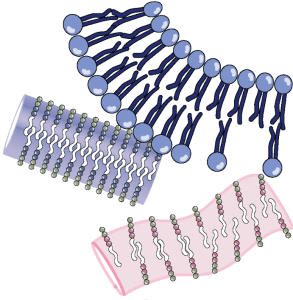
Many naturally occurring peptides containing cationic and hydrophobic domains have evolved to interact with mammalian cell membranes and have been incorporated into materials for non-viral gene delivery, cancer therapy or treatment of microbial infections. Their electrostatic attraction to the negatively charged cell surface and hydrophobic interactions with the membrane lipids enable intracellular delivery or cell lysis. Although the effects of hydrophobicity and cationic charge of soluble molecules on the cell membrane are well known, the interactions between materials with these molecular features and cells remain poorly understood. Here we report that varying the cohesive forces within nanofibres of supramolecular materials with nearly identical cationic and hydrophobic structure instruct cell death or cell survival. Weak intermolecular bonds promote cell death through disruption of lipid membranes, while materials reinforced by hydrogen bonds support cell viability. These findings provide new strategies to design biomaterials that interact with the cell membrane.
Selective Differentiation of Neural Progenitor Cells by High-Epitope Density Nanofibers
Silva, G. A.; Czeisler, C.; Niece, K. L.; Beniash, E.; Kessler, J. A.; Stupp, S. I. “Selective Differentiation of Neural Progenitor Cells by High-Epitope Density Nanofibers” Science 2004, 303 (5662), 1352-1355.
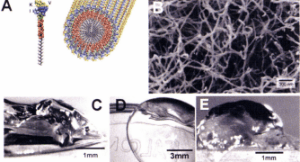
Neural progenitor cells were encapsulated in vitro within a three-dimensional network of nanofibers formed by self-assembly of peptide amphiphile molecules. The self-assembly is triggered by mixing cell suspensions in media with dilute aqueous solutions of the molecules, and cells survive the growth of the nanofibers around them. These nanofibers were designed to present to cells the neurite-promoting laminin epitope IKVAV at nearly van der Waals density. Relative to laminin or soluble peptide, the artificial nanofiber scaffold induced very rapid differentiation of cells into neurons, while discouraging the development of astrocytes. This rapid selective differentiation is linked to the amplification of bioactive epitope presentation to cells by the nanofibers.
Supramolecular Nanostructure Activates TrkB Receptor Signaling of Neuronal Cells by Mimicking Brain-Derived Neurotrophic Factor
Edelbrock, A. N.; Álvarez, Z.; Simkin, D.; Fyrner, T.; Chin, S. M.; Sato, K.; Kiskinis, E.; Stupp, S. I. “Supramolecular Nanostructure Activates TrkB Receptor Signaling of Neuronal Cells by Mimicking Brain-Derived Neurotrophic Factor” Nano Letters 2018, 18 (10), 6237-6247.
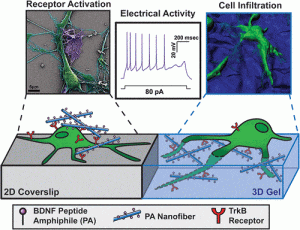
Brain-derived neurotrophic factor (BDNF), a neurotrophin that binds specifically to the tyrosine kinase B (TrkB) receptor, has been shown to promote neuronal differentiation, maturation, and synaptic plasticity in the central nervous system (CNS) during development or after injury and onset of disease. Unfortunately, native BDNF protein-based therapies have had little clinical success due to their suboptimal pharmacological properties. In the past 20 years, BDNF mimetic peptides have been designed with the purpose of activating certain cell pathways that mimic the functional activity of native BDNF, but the interaction of mimetic peptides with cells can be limited due to the conformational specificity required for receptor activation. We report here on the incorporation of a BDNF mimetic sequence into a supramolecular peptide amphiphile filamentous nanostructure capable of activating the BDNF receptor TrkB and downstream signaling in primary cortical neurons in vitro. Interestingly, we found that this BDNF mimetic peptide is only active when displayed on a peptide amphiphile supramolecular nanostructure. We confirmed that increased neuronal maturation is linked to TrkB signaling pathways by analyzing the phosphorylation of downstream signaling effectors and tracking electrical activity over time. Furthermore, three-dimensional gels containing the BDNF peptide amphiphile (PA) nanostructures encourage cell infiltration while increasing functional maturation. Our findings suggest that the BDNF mimetic PA nanostructure creates a highly bioactive matrix that could serve as a biomaterial therapy in injured regions of the CNS. This new strategy has the potential to induce endogenous cell infiltration and promote functional neuronal maturation through the presentation of the BDNF mimetic signal.
Sulfated Glycopeptide Nanostructures for Multipotent Protein Activation
Lee, S. S.; Fyrner, T.; Chen, F.; Alvarez, Z.; Sleep, E.; Chun, D. S.; Weiner, J. A.; Cook, R. W.; Freshman, R. D.; Schallmo, M. S.; Katchko, K. M.; Schneider, A. D.; Smith, J. T.; Yun, C.; Singh, G.; Hashmi, S. Z.; McClendon, M. T.; Yu, Z.; Stock, S. R.; Hsu, W. K.; Hsu, E. L.; Stupp, S. I. “Sulfated Glycopeptide Nanostructures for Multipotent Protein Activation” Nature Nanotechnology 2017, 12, 821-829.
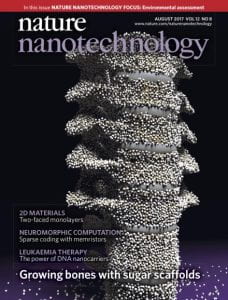
Biological systems have evolved to utilize numerous proteins with capacity to bind polysaccharides for the purpose of optimizing their function. A well-known subset of these proteins with binding domains for the highly diverse sulfated polysaccharides are important growth factors involved in biological development and tissue repair. We report here on supramolecular sulfated glycopeptide nanostructures, which display a trisulfated monosaccharide on their surfaces and bind five critical proteins with different polysaccharide-binding domains. Binding does not disrupt the filamentous shape of the nanostructures or their internal β-sheet backbone, but must involve accessible adaptive configurations to interact with such different proteins. The glycopeptide nanostructures amplified signalling of bone morphogenetic protein 2 significantly more than the natural sulfated polysaccharide heparin, and promoted regeneration of bone in the spine with a protein dose that is 100-fold lower than that required in the animal model. These highly bioactive nanostructures may enable many therapies in the future involving proteins.
Supramolecular Design of Self-Assembling Nanofibers for Cartilage Regeneration
Shah, R. M.; Shah, N. A.; Del Rosario Lim, M. M.; Hsieh, C.; Nuber, G.; Stupp, S. I. “Supramolecular Design of Self-Assembling Nanofibers for Cartilage Regeneration” Proc. Natl. Acad. Sci. 2010, 107 (8), 3293-3298.
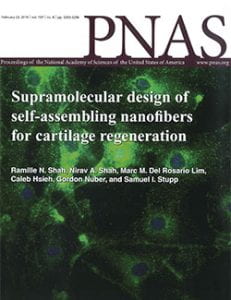
Molecular and supramolecular design of bioactive biomaterials could have a significant impact on regenerative medicine. Ideal regenerative therapies should be minimally invasive, and thus the notion of self-assembling biomaterials programmed to transform from injectable liquids to solid bioactive structures in tissue is highly attractive for clinical translation. We report here on a coassembly system of peptide amphiphile (PA) molecules designed to form nanofibers for cartilage regeneration by displaying a high density of binding epitopes to transforming growth factor β-1 (TGFβ-1). Growth factor release studies showed that passive release of TGFβ-1 was slower from PA gels containing the growth factor binding sites. In vitro experiments indicate these materials support the survival and promote the chondrogenic differentiation of human mesenchymal stem cells. We also show that these materials can promote regeneration of articular cartilage in a full thickness chondral defect treated with microfracture in a rabbit model with or even without the addition of exogenous growth factor. These results demonstrate the potential of a completely synthetic bioactive biomaterial as a therapy to promote cartilage regeneration.
Self-Assembly and Mineralization of Peptide-Amphiphile Nanofibers
Hartgerink, J. D.; Beniash, E.; Stupp, S. I. “Self-Assembly and Mineralization of Peptide-Amphiphile Nanofibers” Science 2001, 294 (5547), 1684-1688.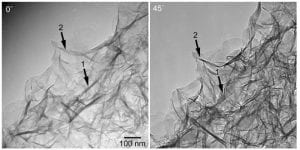
We have used the pH-induced self-assembly of a peptide-amphiphile to make a nanostructured fibrous scaffold reminiscent of extracellular matrix. The design of this peptide-amphiphile allows the nanofibers to be reversibly cross-linked to enhance or decrease their structural integrity. After cross-linking, the fibers are able to direct mineralization of hydroxyapatite to form a composite material in which the crystallographic c axes of hydroxyapatite are aligned with the long axes of the fibers. This alignment is the same as that observed between collagen fibrils and hydroxyapatite crystals in bone.
Energy Materials
Supramolecular-Covalent Hybrid Polymers for Light-Activated Mechanical Actuation
Li, C.; Iscen, A; Sai, H.; Sato, K.; Sather, N. A.; Chin, S.; Àlvarez, Z.; Palmer, L. C.; Schatz, G. C; Stupp, S. I. “Supramolecular-Covalent Hybrid Polymers for Light-Activated Mechanical Actuation” Nature Materials 2020, 19, 900-909.
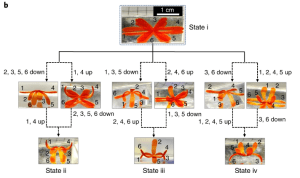
The development of synthetic structures that mimic mechanical actuation in living matter such as autonomous translation and shape changes remains a grand challenge for materials science. In living systems the integration of supramolecular structures and covalent polymers contributes to the responsive behaviour of membranes, muscles and tendons, among others. Here we describe hybrid light-responsive soft materials composed of peptide amphiphile supramolecular polymers chemically bonded to spiropyran-based networks that expel water in response to visible light. The supramolecular polymers form a reversibly deformable and water-draining skeleton that mechanically reinforces the hybrid and can also be aligned by printing methods. The noncovalent skeleton embedded in the network thus enables faster bending and flattening actuation of objects, as well as longer steps during the light-driven crawling motion of macroscopic films. Our work suggests that hybrid bonding polymers, which integrate supramolecular assemblies and covalent networks, offer strategies for the bottom-up design of soft matter that mimics living organisms.
Supramolecular Energy Materials
Dumele, O.; Chen, J.; Passarelli, J. V.; Stupp, S. I. “Supramolecular Energy Materials” Advanced Materials 2020, 32(17), 1907247.
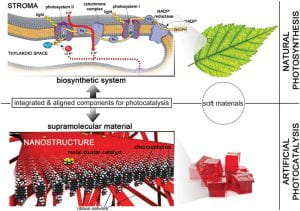
Self-assembly is a bioinspired strategy to craft materials for renewable and clean energy technologies. In plants, the alignment and assembly of the light-harvesting protein machinery in the green leaf optimize the ability to efficiently convert light from the sun to form chemical bonds. In artificial systems, strategies based on self-assembly using noncovalent interactions offer the possibility to mimic this functional correlation among molecules to optimize photocatalysis, photovoltaics, and energy storage. One of the long-term objectives of the field described here as supramolecular energy materials is to learn how to design soft materials containing light-harvesting assemblies and catalysts to generate fuels and useful chemicals. Supramolecular energy materials also hold great potential in the design of systems for photovoltaics in which intermolecular interactions in self-assembled structures, for example, in electron donor and acceptor phases, maximize charge transport and avoid exciton recombination. Possible pathways to integrate organic and inorganic structures by templating strategies and electrodeposition to create materials relevant to energy challenges including photoconductors and supercapacitors are also described. The final topic discussed is the synthesis of hybrid perovskites in which organic molecules are used to modify both structure and functions, which may include chemical stability, photovoltaics, and light emission.
Enhanced Out-of-Plane Conductivity and Photovoltaic Performance in N = 1 Layered Perovskites Through Organic Cation Design
Passarelli, J. V.; Fairfield, D. J.; Sather, N. A.; Hendricks, M. P.; Sai, H.; Stern, C. L.; Stupp, S. I. “Enhanced Out-of-Plane Conductivity and Photovoltaic Performance in N = 1 Layered Perovskites Through Organic Cation Design” Journal of the American Chemical Society 2018, 140(23) 7313-7323.
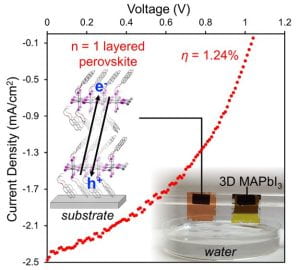
Layered perovskites with the formula (R–NH3)2PbI4 have excellent environmental stability but poor photovoltaic function due to the preferential orientation of the semiconducting layer parallel to the substrate and the typically insulating nature of the R–NH3+ cation. Here, we report a series of these n = 1 layered perovskites with the form (aromatic-O-linker-NH3)2PbI4 where the aromatic moiety is naphthalene, pyrene, or perylene and the linker is ethyl, propyl, or butyl. These materials achieve enhanced conductivity perpendicular to the inorganic layers due to better energy level matching between the inorganic layers and organic galleries. The enhanced conductivity and visible absorption of these materials led to a champion power conversion efficiency of 1.38%, which is the highest value reported for any n = 1 layered perovskite, and it is an order of magnitude higher efficiency than any other n = 1 layered perovskite oriented with layers parallel to the substrate. These findings demonstrate the importance of leveraging the electronic character of the organic cation to improve optoelectronic properties and thus the photovoltaic performance of these chemically stable low n layered perovskites.
Room-Temperature Ferroelectricity in Supramolecular Networks of Charge-Transfer Complexes
Tayi, A. S.; Shveyd, A. K.; Sue, C-H.; Szarko, J. M.; Rolczynski, B. S.; Cao, D.; Kennedy, T. J.; Sarjeant, A. A.; Stern, C. L.; Paxton, W. F.; Wu, W.; Dey, S. K.; Fahrenbach, A. C.; Guest, J. R.; Mohseni, H.; Chen, L. X.; Wang, K. L.; Stoddart, J. F.; Stupp, S. I. “Room-Temperature Ferroelectricity in Supramolecular Networks of Charge-Transfer Complexes” Nature 2012, 488 (7412), 485-489.
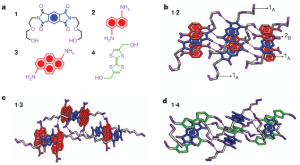
Materials exhibiting a spontaneous electrical polarization that can be switched easily between antiparallel orientations are of potential value for sensors, photonics and energy-efficient memories. In this context, organic ferroelectrics are of particular interest because they promise to be lightweight, inexpensive and easily processed into devices. A recently identified family of organic ferroelectric structures is based on intermolecular charge transfer, where donor and acceptor molecules co-crystallize in an alternating fashion known as a mixed stack: in the crystalline lattice, a collective transfer of electrons from donor to acceptor molecules results in the formation of dipoles that can be realigned by an external field as molecules switch partners in the mixed stack. Although mixed stacks have been investigated extensively, only three systems are known to show ferroelectric switching, all below 71 kelvin. Here we describe supramolecular charge-transfer networks that undergo ferroelectric polarization switching with a ferroelectric Curie temperature above room temperature. These polar and switchable systems utilize a structural synergy between a hydrogen-bonded network and charge-transfer complexation of donor and acceptor molecules in a mixed stack. This supramolecular motif could help guide the development of other functional organic systems that can switch polarization under the influence of electric fields at ambient temperatures.
Light-Driven Expansion of Spiropyran Hydrogels
Li, C.; Iscen, A.; Palmer, L. C.; Schatz, G. C.; Stupp, S. I. “Light-Driven Expansion of Spiropyran Hydrogels” Journal of the American Chemical Society 2020, 142(18), 8447-8453.
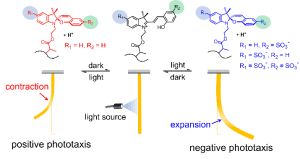
The incorporation of molecular switches in organic structures is of great interest in the chemical design of stimuli-responsive materials that mimic the complex functions of living systems. Merocyanine dyes that convert to spiropyran moieties upon exposure to visible light have been extensively studied as they can be incorporated in hydrated covalent networks that will expel water when this conversion occurs and induce a volumetric shrinkage. We report here on a sulfonate-based water-soluble photoswitch that, in contrast to the well-known systems, triggers a volumetric expansion in hydrogels upon exposure to photons. Contraction is in turn observed under dark conditions in a highly reversible manner. The novel behavior of the photoswitch incorporated in the covalent network was predicted by coarse-grained simulations of the system’s chemical structure. Using pH control and polymeric structures that differ in lower critical solution temperature, we were able to develop hydrogels with highly tunable volumetric expansion. The novel molecular function of the systems developed here led to materials with the negative phototaxis observed in plants and could expand the potential use of hydrogels as sensors, soft robots, and actuators.
Tunable Exciton Binding Energy in 2D Hybrid Layered Perovskites Through Donor–Acceptor Interactions Within the Organic Layer
Passarelli, J. V.; Mauck, C. M.; Winslow, S. W.; Perkinson, C. F.; Bard, J. C.; Sai, H.; Williams, K. W.; Narayanan, A.; Fairfield, D.J.; Hendricks, M. P.; Tisdale, W. A.; Stupp, S. I. “Tunable Exciton Binding Energy in Two-Dimensional Hybrid Layered Perovskites Through Organic-Layer Donor–Acceptor Interactions” Nature Chemistry 2020, 12, 672-682.
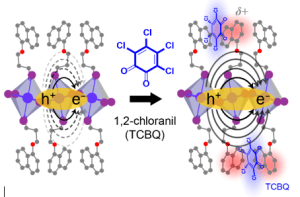
The strength of electrostatic interactions within semiconductors strongly affects their performance in optoelectronic devices. An important target is the tuning of a material’s exciton binding energy—the energy binding an electron–hole pair through the electrostatic Coulomb force—independent of its electronic band gap. Here, we report on the doping of a family of two-dimensional hybrid perovskites, in which inorganic lead halide sheets alternate with naphthalene-based organic layers, with tetrachloro-1,2-benzoquinone (TCBQ). For four out of seven n = 1 perovskites, the incorporation of the electron-accepting TCBQ dopant into the organic sublattice containing the electron-donating naphthalene species enabled the tuning of the materials’ 1s exciton binding energy. The naphthalene–TCBQ electron donor–acceptor interactions increased the electrostatic screening of the exciton, in turn lowering its binding energy relative to the undoped perovskite—by almost 50% in one system. Structural and optical characterization showed that the inorganic lattice is not significantly perturbed even though the layer-to-layer spacing increases upon molecular dopant incorporation.
Self-Assembling Hydrogel Scaffolds for Photocatalytic Hydrogen Production
Weingarten, A. S.; Kazantsev, R. V.; Palmer, L. C.; McClendon, M.; Koltonow, A. R.; Samuel, A. P. S.; Kiebala, D. J.; Wasielewski, M. R.; Stupp, S. I. “Self-Assembling Hydrogel Scaffolds for Photocatalytic Hydrogen Production” Nature Chemistry 2014, 6, 964-970.
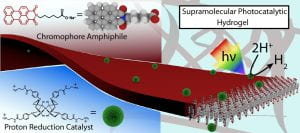
Integration into a soft material of all the molecular components necessary to generate storable fuels is an interesting target in supramolecular chemistry. The concept is inspired by the internal structure of photosynthetic organelles, such as plant chloroplasts, which colocalize molecules involved in light absorption, charge transport and catalysis to create chemical bonds using light energy. We report here on the light-driven production of hydrogen inside a hydrogel scaffold built by the supramolecular self-assembly of a perylene monoimide amphiphile. The charged ribbons formed can electrostatically attract a nickel-based catalyst, and electrolyte screening promotes gelation. We found the emergent phenomenon that screening by the catalyst or the electrolytes led to two-dimensional crystallization of the chromophore assemblies and enhanced the electronic coupling among the molecules. Photocatalytic production of hydrogen is observed in the three-dimensional environment of the hydrogel scaffold and the material is easily placed on surfaces or in the pores of solid supports.
Supramolecular Self-Assembly
Super-Resolution Microscopy Reveals Structural Diversity in Molecular Exchange Among Peptide Amphiphile Nanofibers
da Silva, R. M. P.; Van der Zwaag, D.; Albertazzi, L.; Lee, S. S.; Meijer, E. W.; Stupp, S. I.; “Super-Resolution Microscopy Reveals Structural Diversity in Molecular Exchange Among Peptide Amphiphile Nanofibers” Nature Communications 2016, 7(11561).
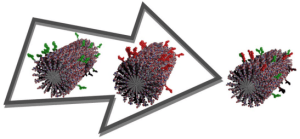
The dynamic behaviour of supramolecular systems is an important dimension of their potential functions. Here, we report on the use of stochastic optical reconstruction microscopy to study the molecular exchange of peptide amphiphile nanofibres, supramolecular systems known to have important biomedical functions. Solutions of nanofibres labelled with different dyes (Cy3 and Cy5) were mixed, and the distribution of dyes inserting into initially single-colour nanofibres was quantified using correlative image analysis. Our observations are consistent with an exchange mechanism involving monomers or small clusters of molecules inserting randomly into a fibre. Different exchange rates are observed within the same fibre, suggesting that local cohesive structures exist on the basis of β-sheet discontinuous domains. The results reported here show that peptide amphiphile supramolecular systems can be dynamic and that their intermolecular interactions affect exchange patterns. This information can be used to generate useful aggregate morphologies for improved biomedical function.
Internal Dynamics of a Supramolecular Nanofiber
Ortony, J. H.; Newcomb, C.; Matson, J. B.; Palmer, L. C.; Doan, P. E.; Hoffman, B. M.; Stupp, S. I. “Internal Dynamics of a Supramolecular Nanofiber” Nature Materials 2014, 13, 812-816.
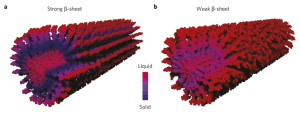
A large variety of functional self-assembled supramolecular nanostructures have been reported over recent decades. The experimental approach to these systems initially focused on the design of molecules with specific interactions that lead to discrete geometric structures, and more recently on the kinetics and mechanistic pathways of self-assembly. However, there remains a major gap in our understanding of the internal conformational dynamics of these systems and of the links between their dynamics and function. Molecular dynamics simulations have yielded information on the molecular fluctuations of supramolecular assemblies, yet experimentally it has been difficult to obtain analogous data with subnanometre spatial resolution. Using site-directed spin labelling and electron paramagnetic resonance spectroscopy, we measured the conformational dynamics of a self-assembled nanofibre in water through its 6.7 nm cross-section. Our measurements provide unique insight for the design of supramolecular functional materials.
A Self-Assembly Pathway to Aligned Monodomain Gels
Zhang, S.; Greenfield, M. A.; Mata, A.; Palmer, L. C.; Bitton, R.; Mantei, J. R.; Aparicio, C.; Olvera de la Cruz, M.; Stupp, S. I. “A Self-Assembly Pathway to Aligned Monodomain Gels” Nature Materials 2010, 9(7), 594-601.
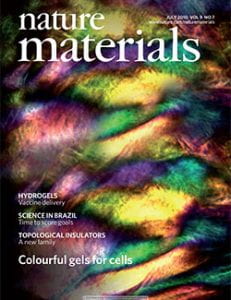
Aggregates of charged amphiphilic molecules have been found to access a structure at elevated temperature that templates alignment of supramolecular fibrils over macroscopic scales. The thermal pathway leads to a lamellar plaque structure with fibrous texture that breaks on cooling into large arrays of aligned nanoscale fibres and forms a strongly birefringent liquid. By manually dragging this liquid crystal from a pipette onto salty media, it is possible to extend this alignment over centimetres in noodle-shaped viscoelastic strings. Using this approach, the solution of supramolecular filaments can be mixed with cells at physiological temperatures to form monodomain gels of aligned cells and filaments. The nature of the self-assembly process and its biocompatibility would allow formation of cellular wires in situ that have any length and customized peptide compositions for use in biological applications.
Self-Assembly of Large and Small Molecules Into Hierarchically Ordered Sacs and Membranes
Capito, R.; Azevedo, H.; Velichko, Y. R., Mata, A.; Stupp, S. I. “Self-Assembly of Large and Small Molecules Into Hierarchically Ordered Sacs and Membranes” Science 2008, 319(5871), 1812-1816
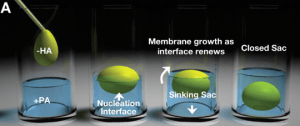
We report here the self-assembly of macroscopic sacs and membranes at the interface between two aqueous solutions, one containing a megadalton polymer and the other, small self-assembling molecules bearing opposite charge. The resulting structures have a highly ordered architecture in which nanofiber bundles align and reorient by nearly 90° as the membrane grows. The formation of a diffusion barrier upon contact between the two liquids prevents their chaotic mixing. We hypothesize that growth of the membrane is then driven by a dynamic synergy between osmotic pressure of ions and static self-assembly. These robust, self-sealing macroscopic structures offer opportunities in many areas, including the formation of privileged environments for cells, immune barriers, new biological assays, and self-assembly of ordered thick membranes for diverse applications.
Metallurgical alloy approach to two-dimensional supramolecular materials
Dannenhoffer, A; Sai, H.; Bruckner E.P.; Ðorđević, L.; Narayanan, A.; Yang, Y.; Ma, X.; Palmer L.C.; Stupp S.I. “Metallurgical Alloy Approach to Two-Dimensional Supramolecular Materials” Chem 2023 9(1), 170-180.
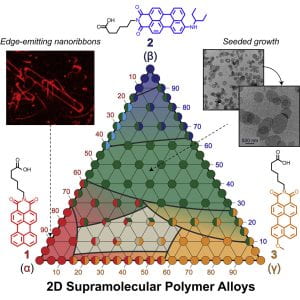
Alloys are normally mixtures of metallic elements used to search for superior functional properties compared with their individual components. Although a quintessential approach to better materials in metallurgy, the concept of alloying has been expanded to other inorganic materials and covalent polymers. We report here on alloy formation of small organic molecules structured as amphiphilic chromophores in water. Using X-ray scattering, microscopy, and optical spectroscopy, we unambiguously demonstrate the formation of supramolecular alloys with changes in physical, photophysical, and mechanical properties. Additionally, we identify single-crystalline, two-dimensional supramolecular polymers containing multiple molecular species, analogous to intermetallic compounds. The mechanism of alloy formation suggests the possibility of controlled growth in these supramolecular assemblies to create emergent functional structures.
Energy Landscapes and Function of Supramolecular Systems
Tantakitti, F.; Boekhoven, J.; Wang, X.; Kazantsev, R.; Yu, T.; Li, J.; Zhuang, E.; Zandi, R.; Ortony, J. H.; Newcomb, C. J.; Palmer, L. C.; Shekhawat, G. S.; Olvera de la Cruz, M.; Schatz, G. C.; Stupp, S. I. “Energy Landscapes and Function of Supramolecular Systems” Nature Materials 2016, 15(4), 469-476. PMCID: PMC4805452
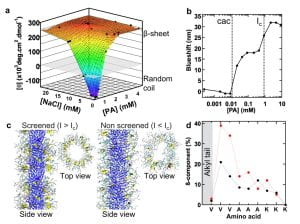
By means of two supramolecular systems—peptide amphiphiles engaged in hydrogen-bonded β-sheets, and chromophore amphiphiles driven to assemble by π-orbital overlaps—we show that the minima in the energy landscapes of supramolecular systems are defined by electrostatic repulsion and the ability of the dominant attractive forces to trap molecules in thermodynamically unfavourable configurations. These competing interactions can be selectively switched on and off, with the order of doing so determining the position of the final product in the energy landscape. Within the same energy landscape, the peptide-amphiphile system forms a thermodynamically favoured product characterized by long bundled fibres that promote biological cell adhesion and survival, and a metastable product characterized by short monodisperse fibres that interfere with adhesion and can lead to cell death. Our findings suggest that, in supramolecular systems, functions and energy landscapes are linked, superseding the more traditional connection between molecular design and function.
Functional Supramolecular Polymers
Aida, T.; Meijer, E. W.; Stupp, S. I. “Functional Supramolecular Polymers” Science 2012, 335 (6070), 813-817.
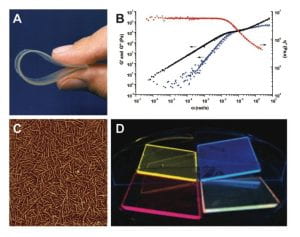
Supramolecular polymers can be random and entangled coils with the mechanical properties of plastics and elastomers, but with great capacity for processability, recycling, and self-healing due to their reversible monomer-to-polymer transitions. At the other extreme, supramolecular polymers can be formed by self-assembly among designed subunits to yield shape-persistent and highly ordered filaments. The use of strong and directional interactions among molecular subunits can achieve not only rich dynamic behavior but also high degrees of internal order that are not known in ordinary polymers. They can resemble, for example, the ordered and dynamic one-dimensional supramolecular assemblies of the cell cytoskeleton and possess useful biological and electronic functions.
Self-Assembly of Peptide Amphiphiles: From Molecules to Nanostructures to Biomaterials
Cui, H.; Webber, M. J.; Stupp, S. I.; “Self-Assembly of Peptide Amphiphiles: From Molecules to Nanostructures to Biomaterials” Biopolymers (Peptide Science) 2010, 94 (1), 1-18.

Peptide amphiphiles are a class of molecules that combine the structural features of amphiphilic surfactants with the functions of bioactive peptides and are known to assemble into a variety of nanostructures. A specific type of peptide amphiphiles are known to self-assemble into one-dimensional nanostructures under physiological conditions, predominantly nanofibers with a cylindrical geometry. The resultant nanostructures could be highly bioactive and are of great interest in many biomedical applications, including tissue engineering, regenerative medicine, and drug delivery. In this context, we highlight our strategies for using molecular self-assembly as a toolbox to produce peptide amphiphile nanostructures and materials and efforts to translate this technology into applications as therapeutics. We also review our recent progress in using these materials for treating spinal cord injury, inducing angiogenesis, and for hard tissue regeneration and replacement.
Supramolecular Materials: Self-Organized Nanostructures
Stupp, S. I.; Le Bonheur, V.; Walker, K.; Li, L. S.; Huggins, K.; Keser, M.; Amstutz, A. “Supramolecular Materials: Self-Organized Nanostructures” Science 1997, 276, 384.
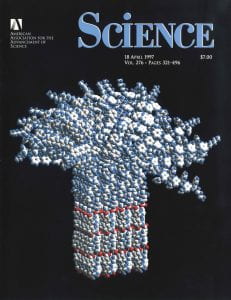
Miniaturized triblock copolymers have been found to self-assemble into nanostructures that are highly regular in size and shape. Mushroom-shaped supramolecular structures of about 200 kilodaltons form by crystallization of the chemically identical blocks and self-organize into films containing 100 or more layers stacked in a polar arrangement. The polar supramolecular material exhibits spontaneous second-harmonic generation from infrared to green photons and has an adhesive tape–like character with nonadhesive-hydrophobic and hydrophilic-sticky opposite surfaces. The films also have reasonable shear strength and adhere tenaciously to glass surfaces on one side only. The regular and finite size of the supramolecular units is believed to be mediated by repulsive forces among some of the segments in the triblock molecules. A large diversity of multifunctional materials could be formed from regular supramolecular units weighing hundreds of kilodaltons.
Lee, S.; Carrow, J.K.; Fraser, L.A.; Yan, J.; Jeyamogan, S.; Sambandam, Y.; Clemons, T.D.; Kolberg-Edelbrock, A.; He, J.; Mathew, J.; Zhang, Z.; Leventhal, J.P.; Gallon, L.; Palmer, L.C.; Stupp, S.I. “Single Cell-Coating with Biomimetic Extracellular Nanofiber Matrices” Acta Biomaterialia 2024, 177, 50-61.
Dannenhoffer, A.; Sai, H.; Bruckner E.P.; Ðorđević, L.; Narayanan, A.; Yang, Y.; Ma, X.; Palmer L.C.; Stupp S.I. “Metallurgical Alloy Approach to Two-Dimensional Supramolecular Materials” Chem 2023, 9(1), 170-180.
Alvarez, Z; Ortega, J. A.; Sato, K.; Sasselli, I. R; Edelbrock, A. N.; Quinlan, K. A.; Mussumeci, C.; Stupp, S. I.; Kiskinis, E. “Artificial Extracellular Matrix Scaffolds of Mobile Molecules Enhance Maturation of Human Stem Cell-Derived Neurons” Cell Stem Cell 2023, https://doi.org/10.1016/j.stem.2022.12.010
Kolberg-Edelbrock, J; Cotey, T.J.; Ma, S.Y.; Kapsalis, L.M.; Bondoc, D.M.; Kolberg-Edelbrock, A.N.; Stupp, S.I. “Biomimetic Extracellular Scaffolds by Microfluidic Superstructuring of Nanofibers” ACS Biomaterials Science and Engineering 2023, DOI: 10.1021/acsbiomaterials.2c01098.
Đorđević, L.; Sai, H, Sather, N.A.; Yang, Y.; Palmer, L.C.; Stupp, S.I. “Heterocyclic Chromophore Amphiphiles and their Supramolecular Polymerization” Angewandte Chemie Int. Ed. e202214997, 2023, https://doi.org/10.1002/anie.202214997
Pavlović, R. Z.; Egner, S.A.; Palmer, L.C.; Stupp. S.I. “Supramolecular Polymers: Dynamic Assemblies of “Dancing” Monomers” Journal of Polymer Science 2023, https://doi.org/10.1002/pol.20230115
Li, C.; Kazem-Rostami, M.; Seale, J.; Zhou, S.; Stupp, S.I. “”Macroscopic Actuation of Bisazo Hydrogels Driven by Molecular Photoisomerization” Chemistry of Materials 2023, https://doi.org/10.1021/acs.chemmater.3c00062
Searl, T.; Martin,S.; Harrington, D.; Ohlander, S.; Stupp, S.I.; Mcvary, K.; Podlasek, C. “RNAseq and Pathway Analysis of Rat Penis with Cavernous Nerve Injury and Sonic Hedgehog Treatment by Peptide Amphiphile” The Journal of Urology 2023, 209(4), e362.
Martin,S.; Deng, J.; Searl, T.; Ohlander, S.; Harrington, D.; Stupp,S.I.; Mcvary,K.; Podlasek, C. “Analysis of BMP4 and GREMLIN as targets of SHH signaling and regulators of the collagen axis in the penis” The Journal of Sexual Medicine, 2023, 20(1).
Searl, T.; Martin,S.; Harrington, D.; Ohlander, S.; Stupp, S.I.; Mcvary, K.; Podlasek, C. “RNAseq and Pathway Analysis of Rat Penis with Cavernous Nerve Injury and Sonic Hedgehog Treatment by Peptide Amphiphile” The Journal of Sexual Medicine 2023, 20(1).
Duan, J; Shabbir, H; Chen, Z; Bi, W; Liu, Q; Sui, J ; Đorđević, L; Stupp, S.I.; Chapman, K; Martinson, A; Li, A; Goswami, S; Getman, R ; Hupp, J. “Synthetic access to a framework-stabilized and fully sulfided analogue of an Anderson polyoxometalate that is catalytically competent for reduction reactions” Journal of the American Chemical Society 2023, 145(13), 7268–7277.
Li, C.; Xiong, Q.; Clemmons, T.; Sai, H.; Yang, Y.; Sangji, M.H.; Iscen, A.; Palmer, L.C.; Schatz, G.C.; Stupp, S.I. “Role of Supramolecular Polymers in Photo-actuation of Spiropyran Hydrogels” Chemical Science. 2023, DOI: 10.1039/D3SC00401E
Qiu, R; Chen, F; Alvarez, Z; Clemons, T; Biswas, S; Karver, M.; Takata , N; Sai, H; Peng, H; Weigand, S; Palmer, L.C.; Stupp, S.I. “Supramolecular Nanofibers Block SARS-CoV-2 Entry into Human Host Cells” ACS Applied Materials & Interfaces 2023, 15 (22), 26340-26348PMCID #PMC10237298
Yang, Y.; Li, C.; Palmer, L.C.; Stupp, S.I. “Autonomous Hydrogel Locomotion Regulated by Light and Electric Fields” Science Advances 2023, 9 (31), eadi4566
Smith, C. S.; Álvarez, Z.; Qui, R.; Sasseli, I.; Clemons, T.; Ortega, J.A.; Viliela-Picos, M.; Wellman, H.; Kiskinis, E.; Stupp, S.I. “Enhanced Neuron Growth and Electrical Activity by a Supramolecular Netrin-1 Mimetic Nanofiber” ACS Nano 2023, https://doi.org/10.1021/acsnano.3c04572
Pavlović, R.Z.; Finnegan, T. J.; Metlushko, A.; Hansen, A. L.; Waudby, C. A.; Wang, X.; Hoefer, N.; McComb, D. W.; Pavic, A.; Plackic, N.; Novakovic, J.; Bradic, J.; Jeremic, N.; Jakovljevic, V.; Smit, B.; Matic, S.; Alvarez-Saavedra, M. A., Capo, I.; Moore, C. E.; Stupp, S. I. “Dynamic and Assembly Characteristics of Deep‐Cavity Basket Acting as a Host for Inclusion Complexation of Mitoxantrone in Biotic and Abiotic Systems” Chemistry : a European Journal 2023, 29(68), e202303374
Ortega, J. A; Sasselli, I. R.; Boccitto, M.; Fleming, A. C.; Fortuna, T.; Li, Y.; Sato, K.; Clemons, T. D.; McKenna, E.; Nguyen, T. P.; Anderson, E.; Ichida, J.; Pandey, U.; Wolin, S.; Stupp, S. I.; Kiskinis, E. “CLIP-Seq Analysis Enables the Design of Ribosomal RNA Bait Oligonucleotides That Protect Against C9ORF72 ALS/FTD-Associated Poly-GR Pathophysiology” Science Advances 2023, 9(43).
Stone, E.B.S; Đorđević, L.; Stupp, S.I.; Weiss, E.A.; Arcudi, F.; Hupp, J.T. “Selective Photocatalytic Reduction of Acetylene to Ethylene Powered by a Cobalt-Porphyrin Metal–Organic Framework” ACS Energy Letters 2023, 8(11), 4684–4693.
Zhou,Y.; Fyrner, T; Chen. C; Sather, N.; Hsu, E.; Stupp, S.I.; Snead, M.L. “Optimization of peptide amphiphile-lipid raft interaction by changing PA lipophilicity” Acta Biomaterialia 2023, 164, 377–386
McClendon, M.; Ji, W.; Greene, A.C.; Sai, H.; Sangji, M. H.; Chen, C.H.; Lee, S.S.; Katchko, K.; Jeong, S.S.; Kannan, A.; Weiner, J.; Cook, R.; Driscoll, A.; Lubbe, R.; Chang. K.; Haleem, M.; Chen, F.; Qiu, R.; Chun, D.; Stock, S.R.; Hsu, W.K.; Hsu, E.L.; Stupp, S.I. “A Supramolecular Polymer-Collagen Microparticle Slurry for Bone Regeneration with Minimal Growth Factor” Biomaterials 2023, 302, 122357.
Sasselli, I. R.; Syrgiannis, Z.; Sather, N.; Palmer, L. C; Stupp. S. I.; “Modelling Interactions Within and Between Peptide Amphiphile Supramolecular Filaments” Physical Chemistry B 2022,126(3), 650-659.
Dumele, O.; Dordevic, L.; Sai, H.; Cotey, T. J.; Sangji, M. H.; Sato, K.; Dannenhoffer, A. J.; Stupp, S. I. “Photocatalytic Aqueous CO2 Reduction to CO and CH4 Sensitized by Ullazine Supramolecular Polymers” Journal of the American Chemical Society 2022, 144 (7), 3127-3136.
Aggarwal, A.; Li, C.; Stupp, S. I.; Olvera de la Cruz, M. “Controlling the Shape Morphology of Origami-Inspired Photoresponsive Hydrogels” Soft Matter 2022, 18, 2193-2201. PMCID: PMC8989053 NIHMSID: NIHMS1785846
Nap, R. J.; Qiao, B.; Palmer, L. C.; Stupp, S. I.; Olvera de la Cruz, M.; Szleifer, I. “Acid-Base Equilibrium and Dielectric Environment Regulate Charge in Supramolecular Nanofibers” Frontiers in Chemistry 2022, 10:852164. PMCID: PMC8965714
Bruckner, E.P.; Stupp, S. I. “Designing Supramolecular Polymers with Nucleation and Growth Processes” Polymer International 2022, 71, 590-595.
Qiu, R.; Sasselli, I. R.; Álvarez, Z.; Sai, H.; Ji, W.; Palmer, L. C.; Stupp, S. I. “Supramolecular Copolymers of Peptides and Lipidated Peptides and their Therapeutic Potential” Journal of the American Chemical Society 2022, 144 (12) 5532-5574.
Arcudi, F.; Dordevic, L.; Schweitzer, N.; Stupp, S. I.; Weiss, E. A. “Selective Visible-Light Photocatalysis of Acetylene to Ethylene Using a Cobalt Molecular Catalyst and Water as a Proton Source” Nature Chemistry 2022, https://doi.org/10.1038/s41557-022-00966-5.
Bruckner, E. P.; Curk, T.; Dordevic, L.; Wang, Z.; Yang, Y.; Qiu, R.; Dannenhoffer, A. J.; Sai, H.; Kupferberg, J.; Palmer, L. C.; Luijten, E.; Stupp, S. I. “Hybrid Nanocrystals of Small Molecules and Chemically Disordered Polymers” ACS Nano 2022, 16 (6), 8993-9003.
Ledford, B. T.; Akerman, A. W; Sun, K.; Gillis, D. C.; Weiss, J. M.; Vang, J.; Willcox, S.; Clemons, T. D.; Sai, H.; Qiu, R.; Karver, M. R.; Griffith, J. D.; Tsihlis, N. D.; Stupp, S.I.; Ikonomidis, J. S.; Kibbe, M. R. “Peptide Amphiphile Supramolecular Nanofibers Designed to Target Abdominal Aortic Aneurysms” ACS Nano 2022, 16 (5), 7309-7322.
Podlasek, C; Martin,S.; Deng J; Searl, T.;Ohlander,S.; Harrington,D.; Stupp,S.I.; Dynda D.; McVary,K. “Sonic Hedgehog Signaling in Primary Culture of Human Corpora Cavernosal Tissue from Prostatectomy, Diabetic, and Peyronie’s Patients” The Journal of Sexual Medicine 2022, 19 (8),1228-1242.
Yuan, S.; Lewis, J.; Sai, H.; Weigand, S.; Palmer, L.; Stupp, S.I. “Peptide Sequence Determines Structural Sensitivity to Supramolecular Polymerization Pathways and Bioactivity” Journal of the American Chemical Society 2022,144 (36) 16512-16523.
Bakshi, R.; Hokugo, A.; Khalil, D.; Wang, L.; Shibuya, Y.; Zhou, S.; Zhang, Z.; Rezzadeh, K.; McClendon, M.; Stupp, S. I.; Jarrahy, R. “A Chemotactic Functional Scaffold with VEGF-Releasing Peptide Amphiphiles Facilitates Bone Regeneration by BMP-2 in Large-Scale Rodent Cranial Defect Model” Plastic and Reconstructive Surgery 2021, 147(2), 386-397.
Dems, D.; Freeman, R.; Riker. K. D.; Coradin, T.; Stupp, S. I.; Aimé, C. “Multivalent Clustering of Adhesion Ligands in Nanofiber-Nanoparticle Composites” Acta Biomaterialia 2021, 119, 303-311.
Grabicki, N.; Dumele, O.; Sai, H.; Power-Riggs, N. E.; Phelan, B. T.; Sangji, M. H.; Chapman, C. T.; Passarelli, J. V.; Dannenhoffer, A. J.; Wasielewski, M. R.; Stupp, S. I. “Polymorphism and Opto-Electronic Properties in Crystalline Supramolecular Polymers” Chemistry of Materials 2021, 33(2), 706–718.
Sather, N. A.; Sai, H.; Sasselli, I. R.; Sato, K.; Ji, W.; Synatschke, C. V.; Zambrotta, R. T.; Edelbrock, J. F.; Kohlmeyer, R. R.; Hardin, J. O.; Berrigan, J. D.; Durstock, M. F.; Mirau, P.; Stupp, S. I. “3D Printing of Supramolecular Polymer Hydrogels with Hierarchical Structure” Small 2021, 17(5), 2005743.
Bury, M. I.; Fuller, N. J.; Clemons, T. D.; Sturm, R. M.; Morrison, C. D.; Lisy-Snow, D. C.; Nolan, B. G.; Tarczynski, C.; Ayello, E. M. T.; Boyce, A.; Muckian, B.; Ahmad, N.; Hunter, C. J.; Karver, M. R.; Stupp, S. I.; Sharma, A. K. “Self-Assembling Nanofibers Inhibit Inflammation in a Murine Model of Crohn’s Disease-like Ileitis” Advanced Therapeutics 2021, 4(4), 2000274.
Li, C.; Xue, Y.; Han, M.; Palmer, L. C.; Rogers, J. A.; Huang, Y.; Stupp, S. I. “Synergistic Photoactuation of Bilayered Spiropyran Hydrogels for Predictable Origami-Like Shape Change” Matter 2021, 4(4), 1377-1390.
Edelbrock, A. N.; Clemons, T. D.; Chin, S. M.; Roan, J. J. W.; Bruckner, E. P.; Álvarez, Z.; Edelbrock, J.; Wek, K. S.; Stupp, S. I. “Superstructured Biomaterials Formed by Exchange Dynamics and Host-Guest Interactions in Supramolecular Polymers” Advanced Science 2021, 8(8): 2004042. PMCID: PMC8061421
McCallum, N. C.; Son, F. A.; Clemons, T. D.; Weigand, S. J.; Gnanasekaran, K.; Battistella, C.; Barnes, B. E.; Abeyratne-Perera, K.; Siwicka, Z. E.; Forman, C. J.; Zhou, X.; Moore, M. H.; Savin, D. A.; Stupp, S. I.; Wang, Z.; Vora, G.; Johnson, B. J.; Farha, O. K.; Gianneschi, N. C. “Allomelanin – A Biopolymer of Intrinsic Microporosity” Journal of the American Chemical Society 2021, 143(10), 4005-4016.
Martin, S.; Harrington, D. A.; Ohlander, S.; Stupp, S. I.; McVary, K. T.; Podlasek, C. A. “Caspase Signaling in ED Patients and Animal Models” Journal of Sexual Medicine 2021, 18(4), 711-722. PMCID: PMC8068676
Chen, C. H.; Palmer, L. C.; Stupp, S. I. “Self-Sorting in Supramolecular Assemblies” Soft Matter 2021, 17, 3902-3912. PMCID: PMC8049983
Cotey, T. J.; Sai, H.; Perez, C.; Palmer, L.C.; Stupp, S. I. “Hybrid Gels via Bulk Interfacial Complexation of Supramolecular Polymers and Polyelectrolytes” Soft Matter 2021 17, 4949-4956.
Dannenhoffer, A. J.; Sai, H.; Harutyunyan, B.; Narayanan, A.; Powers-Riggs, N. E.; Edelbrock, A. N.; Passarelli, J. V.; Weigand, S. J.; Wasielewski, M. R.; Bedzyk, M. J.; Palmer, L. C.; Stupp, S. I. ”Growth of Extra-Large Chromophore Supramolecular Polymers for Enhanced Hydrogen Production” Nano Letters 2021 21(9), 3745−3752.
Newton, E. R.; Gillis, D. C.; Sun, K.; Dandurand, B. R.; Siletzky, R.; Biswas, S.; Karver, M. R.; Tsihlis, N. D.; Stupp, S. I.; Kibbe, M. R. “Evaluation of a Targeted Drug-Eluting Intravascular Nanotherapy to Prevent Neointimal Hyperplasia in an Atherosclerotic Rat Model” Advanced NanoBiomed Research 2021, 1(7), 2000093. NIHMSID: NIHMS1783922
Marulanda, K.; Mercel, A.; Gillis, D. C.; Sun, K.; Gambarian, M.; Roark, J.; Weiss, J.; Tsihlis, N. D.; Karver, M. R.; Centeno, S. R.; Peters, E. B.; Clemons, T. D.; Stupp, S. I.; McLean, S. E.; Kibbe, M. R. “Intravenous Delivery of Lung-Targeted Nanofibers for Pulmonary Hypertension in Mice” Advanced Healthcare Materials 2021, 10(13), 2100302. PMCID: PMC8273153
Mercel, A. I.; Marulanda, K.; Gillis, D. C.; Sun, K.; Clemons, T. D.; Willcox, S.; Griffith, J.; Peters, E. B.; Karver, M. R.; Tsihlis, N. D.; Maile, R.; Stupp, S. I.; Kibbe, M. R. “Development of Novel Nanofibers Targeted to Smoke-Injured Lungs” Biomaterials 2021, 274, 120862.
Jiao, Y.; Dordevic, L.; Mao, H.; Young, R. M.; Jaynes, T.; Chen, H.; Qiu, Y.; Cai, K.; Zhang, L.; Chen, X-Y.; Feng, Y.; Wasielewski, M. R.; Stupp, S. I.; Stoddart, J. F. “A Donor–Acceptor [2]Catenane for Visible Light Photocatalysis” Journal of the American Chemical Society 2021, 143(21), 8000–8010.
Chen, X-Y.; Chen, H; Dordevic, L.; Guo, Q-H.; Wu, H.; Wang, Y.; Zhang, L.; Jiao, Y.; Cai, K.; Chen, H.; Stern, C. L.; Stupp, S. I.; Snurr, R. Q.; Shen, D.; Stoddart, J. F. “Selective Photodimerization in a Cyclodextrin Metal-Organic Framework” Journal of the American Chemical Society 2021, 143(24), 9129-9139.
Sangji, M. H.; Sai, H.; Chin, S. M.; Lee, S. R.; Sasselli, I. R.; Palmer, L. C.; Stupp, S. I. “Supramolecular Interactions and Morphology of Self-assembling Peptide Amphiphile Nanostructures” Nano Letters 2021, 21(14), 6146-6155.
Peters, E. B.; Karver, M. R.; Sun, K.; Gillis, D. C.; Biswas, S.; Clemons, T. D.; He W.; Tsihlis, N. D; Stupp, S. I.; Kibbe, M. R. “Self-Assembled Peptide Amphiphile Nanofibers for Controlled Therapeutic Delivery to the Atherosclerotic Niche” Advanced Therapeutics 2021, 4(9) 22100103. PMCID: PMC8680456
Xing, H.; Chin, S. M.; Udumula, V. R.; Krishnaiah, M.; Rodrigues de Almeida, N.: Huck-Iriart, C.; Picco, A. S.; Lee, S. R.; Zaldivar, G.; Jackson, K. A.; Tagliazucchi, M.; Stupp, S. I.; Conda-Sheridan, M. “Control of Peptide Amphiphile Supramolecular Nanostructures by Isosteric Replacement” Biomacromolecules 2021, 22(8), 3274-3283.
Godbe, J. M; Freeman, R.; Lewis, J. A.; Sasselli, I. R.; Sangji, M. H; Stupp, S. I.“Hydrogen Bonding Stiffens Peptide Amphiphile Supramolecular Filaments by Aza-Glycine Residues” Acta Biomaterialia, 2021, 135, 87-99.
Arcudi, F.; Dordevic, L.; Nagasing, B.; Stupp, S. I.; Weiss, E. A. “Quantum Dot-Sensitized Photoreduction of CO2 in Water with Turnover Number >80,000” Journal of the American Chemical Society 2021, 143(43), 18131-18138.
Martin, S.; Harrington, D. A.; Ohlander, S.; Stupp, S. I.; McVary, K. T.; Podlasek, C. A. “Peptide Amphiphile Nanofiber Hydrogel Delivery of Sonic Hedgehog Protein to the Penis and Cavernous Nerve Suppresses Intrinsic and Extrinsic Apoptotic Signaling Mechanisms, Which are an Underlying Cause of Erectile Dysfunction” Nanomedicine 2021; 37:102444. PMC: 8464506
Álvarez, Z.; Edelbrock, A. N.; Sasselli, I. R.; Ortega, J. A.; Syrgiannis, Z.; Mirau, P. A.; Chen, F.; Qiu, R.; Chin, S.M.; Kiskinis, E.; Stupp, S. I. “Bioactive Scaffolds With Enhanced Supramolecular Motion Promote Recovery from Spinal Cord Injury” Science 2021, 374(6569), 848-856. PMCID: PMC8723833
Xiong, Q; Stupp, S. I.; Schatz, G. C. “Molecular Insight into the β-Sheet Twist and Related Morphology of Self-Assembled Peptide Amphiphile Ribbons” Physical Chemistry Letters 2021, 12(46), 11238–11244.
Stupp, S. I.; Palmer, L. C.; Sai, H. “Crystalline Supramolecular Polymers: Dynamics, Chirality, and Function” Israel Journal of Chemistry 2021, 61(11-12), 873-883.
Sai, H.; Erbas, A.; Dannenhoffer, A.; Huang, D.; Weingarten, A.; Siismets, E.; Jang, K.; Qu, K.; Palmer, L. C.; Olvera de la Cruz, M.; Stupp, S. I. “Chromophore Amphiphile-Polyelectrolyte Hybrid Hydrogels for Photocatalytic Hydrogen Production” Journal of Materials Chemistry A 2020, 8(1), 158-168.
McClelland, K. P.; Clemons, T. D.; Stupp, S. I.; Weiss, E. A. “Semiconductor Quantum Dots are Efficient and Recyclable Photocatalysts for Aqueous PET-RAFT Polymerization” ACS Macro Letters 2020, 9, 7-13.
Chen, Y.; Li, P.; Zhou, J.; Buru, C. T.; Dordevic, L.; Li, P.; Zhang, X.; Cetin, M. M; Stoddart, J. F.; Stupp, S. I.; Wasielewski, M. R.; Farha, O. K.; “Integration of Enzymes and Photosensitizers in a Hierarchical Mesoporous Metal–Organic Framework for Light-Driven CO2 Reduction” Journal of the American Chemical Society 2020, 142(4), 1768-1773.
Godbe, J. M.; Freeman, R.; Burbulla, L. F.; Lewis, J.; Krainc, D.; Stupp, S. I. “Gelator Length Precisely Tunes Supramolecular Hydrogel Stiffness and Neuronal Phenotype in 3D Culture” ACS Biomaterials Science & Engineering 2020, 6(2), 1196-1207. PMCID: PMC7575210
Stupp, S. I. “On Supramolecular Self-Assembly: Interview with Samuel Stupp” Advanced Materials 2020, 32(20), 1906741.
Nayak, S.; Mahenthiran, A.; Yang, Y.; McClendon, M.; Mania-Farnell, B.; James, C. D.; Kessler, J. A.; Tomita, T.; Cheng, S-Y.; Stupp, S. I.; Xi, G. “Bone Morphogenetic Protein 4 Targeting Glioma Stem-Like Cells for Malignant Glioma Treatment: Latest Advances and Implications for Clinic Application” Cancers 2020, 12(2), 516. PMCID: PMC7072475
Kassam, H. A.; Gillis, D. C.; Dandurand, B. R.; Karver, M. R.; Tsihlis, N. D.; Stupp, S.I.; Kibbe, M. R.; “Development of Fractalkine-Targeted Nanofibers that Localize to Sites of Arterial Injury” Nanomaterials 2020, 10(3), 420. PMCID: PMC7152859
Stupp, S. I.; Clemons, T. D.; Carrow, J K.; Sai, H.; Palmer, L. C. “Supramolecular and Hybrid Bonding Polymers” Israel Journal of Chemistry 2020, 60(1-2), 124-131.
Dumele, O.; Chen, J.; Passarelli, J. V.; Stupp, S. I. “Supramolecular Energy Materials” Advanced Materials 2020, 32(17), 1907247.
Shklyaev, O. E.; Yashin, V. V.; Stupp, S. I.; Balazs, A. C. “Enhancement of Chemical Oscillations by Self-Generated Convective Flows” Communications Physics 2020, 3, 70.
Li, C.; Iscen, A.; Palmer, L. C.; Schatz, G. C.; Stupp, S. I. “Light-Driven Expansion of Spiropyran Hydrogels” Journal of the American Chemical Society 2020, 142(18), 8447-8453.
Sai, H.; Lau, G. C; Dannenhoffer, A. J.; Chin, S. M; Dordevic, L.; Stupp, S. I. “Imaging Supramolecular Morphogenesis with Confocal Laser Scanning Microscopy at Elevated Temperatures” Nano Letters 2020, 20(6), 4234-4241.
Klein, M. K.; Kassam, H. A.; Lee, R. H.; Bergmeier, W.; Peters, E. B.; Gillis, D. C.; Dandurand, B. R.; Roan, J. R.; Karver, M. R.; Struble, M. D.; Clemons, T. D.; Palmer, L. C.; Gavitt, B.; Pritts, T. A.; Tsihlis, N. D.; Stupp , S. I.; Kibbe, M. R. “Development of Optimized Tissue Factor-Targeted Peptide Amphiphile Nanofibers to Slow Noncompressible Torso Hemorrhage” ACS Nano 2020, 14(6), 6649-6662. PMCID: PMC7587470
Li, C.; Iscen, A; Sai, H.; Sato, K.; Sather, N. A.; Chin, S.; Àlvarez, Z.; Palmer, L. C.; Schatz, G. C; Stupp, S. I. “Supramolecular-Covalent Hybrid Polymers for Light-Activated Mechanical Actuation” Nature Materials 2020, 19, 900-909.
Passarelli, J. V.; Mauck, C. M.; Winslow, S. W.; Perkinson, C. F.; Bard, J. C.; Sai, H.; Williams, K. W.; Narayanan, A.; Fairfield, D.J.; Hendricks, M. P.; Tisdale, W. A.; Stupp, S. I. “Tunable Exciton Binding Energy in Two-Dimensional Hybrid Layered Perovskites Through Organic-Layer Donor–Acceptor Interactions” Nature Chemistry 2020, 12, 672-682.
Wester, J. R.; Lewis, J. A.; Freeman, R.; Sai, H.; Palmer, L. C.; Henrich, S. E.; Stupp, S. I. “Supramolecular Exchange Among Assemblies of Opposite Charge Leads to Hierarchical Structures” Journal of the American Chemical Society 2020, 142(28), 12216-12225.
Lewis, J. A.; Freeman, R.; Carrow, J. K.; Clemons, T. D.; Palmer, L. C.; Stupp, S. I. “Transforming Growth Factor β-1 Binding by Peptide Amphiphile Hydrogels” ACS Biomaterials Science and Engineering 2020, 6(8), 4551-4560.
Sun, H.; Cao, W.; Zang, N.; Clemons, T. D.; Scheutz, G. M.; Hu, Z.; Thompson, M. P.; Liang, Y.; Vratsanos, M.; Zhou, X.; Choi, W.; Sumerlin, B. S.; Stupp, S. I.; Gianneschi, N. C. “Proapoptotic Peptide Brush Polymer Nanoparticles via Photoinitiated Polymerization-Induced Self-Assembly” Angewandte Chemie 2020, 59(43), 19136-19142. PMCID: PMC7722202
Thames, A.; Wolniak, K.; Stupp, S. I.; Jewett, M. “Principles Learned from the International Race to Develop a Safe and Effective COVID-19 Vaccine” ACS Central Science 2020, 6(8), 1341-1347. PMCID: PMC7374935
Chen, C. H.; Hsu, E. L.; Stupp, S. I. “Supramolecular Self-Assembling Peptides to Deliver Bone Morphogenetic Proteins for Skeletal Regeneration” BONE 2020, 141, 115565. PMCID: PMC7680412
Kassam, H. A.; Bahnson, E. M.; Cartaya, A.; Jiang, W.; Avram, M. J.; Tsihlis, N. D.; Stupp, S. I.; Kibbe, M. R. “Pharmacokinetics and Biodistribution of a Collagen-Targeted Peptide Amphiphile for Cardiovascular Applications” Pharmacology Research & Perspectives 2020, 8(6), e00672. PMCID: PMC7580710
Clemons, T. D.; Stupp, S. I. “Design of Materials with Supramolecular Polymers” Progress in Polymer Science 2020, 111, 101310. PMCID: PMC7560124
Li, C.; Lau, G. C.; Yuan, H.; Aggarwal, A.; Dominguez, V. L.; Liu, S.; Sai, H.; Palmer, L. C.; Sather, N. A.; Pearson, T.; Freedman, D.; Amiri, P. K.; Olvera de la Cruz, M.; Stupp, S. I. “Fast and Programmable Locomotion of Hydrogel-Metal Hybrids Under Light and Magnetic Fields” Science Robotics 2020, 5(49), eabb9822.
Hernandez-Garcia, A.; Álvarez, Z.; Simkin, D.; Madhan, A.; Pariset, E.; Tantakitti, F.; de J. Vargas-Dorantes, O.; Lee, S. S.; Kiskinis, E.; Stupp, S. I. “Peptide-siRNA Supramolecular Particles for Neural Cell Transfection” Advanced Science 2019, 6(3), 1801458. PMCID: PMC6364495
Fairfield, D.; Sai, H.; Narayanan, A.; Passarelli, J.; Chen, M.; Palasz, J.; Palmer, L. C.; Wasielewski, M. R.; Stupp, S. I. “Structure and Chemical Stability in Perovskite-Polymer Hybrid Photovoltaic Materials” Journal of Materials Chemistry A 2019, 7(4), 1687-1699.
Dobbs, R.; Kalmanek, E.; Choe, S.; Harrington, D. A.; Stupp, S. I.; McVary, K. T.; Podlasek, C. A.; “Sonic Hedgehog Regulation of Cavernous Nerve Regeneration and Neurite Formation in Aged Pelvic Plexus” Experimental Neurology 2019, 312, 10-19. PMCID: PMC6342483
Peters, E. B.; Tsihlis, N. D.; Karver, M. R.; Chin, S. M.; Musetti, B.; Ledford, B. T.; Bahnson, E. M.; Stupp, S. I.; Kibbe, M. R. “Atheroma Niche-Responsive Nanocarriers for Immunotherapeutic Delivery” Advanced Healthcare Materials, 2019, 8(3), 1801545. PMCID: PMC6367050
Hu, Y-S.; Do, J.; Edamakanti, C. R.; Kini, A. R.; Martina, M.; Stupp, S. I.; Opal, P. “Self-Assembling VEGF Nanoparticles Improve Function in Spinocerebellar Ataxia Type 1” Brain 2019, 142(2), 312-321. PMCID: PMC6351780
Zhou, S.; Hokugo, A.; McClendon, M.; Zhang, Z.; Bakshi, R.; Wang, L.; Segovia, L. A.; Rezzadeh, K.; Stupp, S. I.; Jarrahy, R. “Bioactive Peptide Amphiphile Nanofiber Gels Enhance Burn Wound Healing” Burns 2019, 45(5), 1112-1121.
Mansukhani, N. A.; Peters, E. B.; So, M. M.; Albaghdadi, M. S.; Wang, Z.; Karver, M. R.; Clemons, T. D.; Laux, J. P.; Tsihlis, N. D.; Stupp, S. I.; Kibbe, M. R. “Peptide Amphiphile Supramolecular Nanostructures as a Targeted Therapy for Atherosclerosis” Macromolecular Bioscience 2019, 19(6), 1900066. PMCID: PMC6579116
Dannenhoffer, A.; Sai, H.; Huang, D.; Nagasing, B.; Harutyunyan, B.; Fairfield, D. J.; Aytun, T.; Chin, S. M.; Bedzyk, M. J.; Olvera de la Cruz, M.; Stupp, S. I. “Impact of Charge Switching Stimuli on Supramolecular Perylene Monoimide Assemblies” Chemical Science 2019, 10(22), 5779-5786.
Sato, K.; Ji, W.; Álvarez, Z.; Palmer, L. C.; Stupp, S. I. “Chiral Recognition of Lipid Bilayer Membranes by Supramolecular Assemblies of Peptide Amphiphiles” ACS Biomaterials Science & Engineering 2019, 5(6), 2786-2792.
Choe, S.; Kalmanek, E.; Bond, C.; Harrington, D. A.; Stupp, S. I.; McVary, K. T.; Podlasek, C. A. “Optimization of Sonic Hedgehog Delivery to the Penis From Self-Assembling Nanofiber Hydrogels to Preserve Penile Morphology After Cavernous Nerve Injury” Nanomedicine: Nanotechnology, Biology, and Medicine 2019, 20, 102033. PMCID: PMC7194284
Serrano, C. M; Freeman, R.; Godbe, J.; Lewis, J.A.; Stupp, S. I. “DNA-Peptide Amphiphile Nanofibers Enhance Aptamer Function” ACS Applied Bio Materials 2019, 2(7), 2955-2963. PMCID: PMC7523912
Yi, S.; Zhang, X.; Sangji, M. H.; Liu, Y.; Allen, S. D.; Xiao, B.; Bobbala, S.; Braverman, C. L.; Cai, L.; Hecker, P. I.; DeBerge, M.; Thorp, E. B.; Temel, R. E.; Stupp, S. I.; Scott, E. A. “Surface Engineered Polymersomes for Enhanced Modulation of Dendritic Cells During Cardiovascular Immunotherapy” Advanced Functional Materials 2019, 29(42), 1904399. PMCID: PMC8320590
Moyer, T. J.; Chen, F.; Toft, D. J.; Ruff, Y.; Cryns, V. L.; Stupp, S. I. “Self-Assembled Peptide Nanostructures Targeting Death Receptor 5 and Encapsulating Paclitaxel as a Multifunctional Cancer Therapy” ACS Biomaterials Science and Engineering 2019, 5(11), 6046-6053. PMCID: PMC7725269
Beldjoudi, Y.; Narayanan, A.; Roy, I.; Pearson, T. J.; Cetin, M. M.; Nguyen, M. T.; Krzyaniak, M. D.; Alsubaie, F. M.; Wasielewski, M. R.; Stupp, S. I.; Stoddart, J. F. “Supramolecular Tessellations by a Rigid Naphthalene Diimide Triangle” Journal of the American Chemical Society 2019, 141(44), 17783-17795.
Lau, G. C.; Sather, N. A.; Sai, H.; Waring, E. M.; Deiss-Yehiely, E.; Barreda. L.; Beeman, E. A.; Palmer, L. C.; Stupp, S. I. “Oriented Multiwalled Organic-Co(OH)2 Nanotubes for Energy Storage” Advanced Functional Materials 2018, 28(3), 1702320.
Yun, C.; Katchko, K. M.; Schallmo, M. S.; Jeong, S.; Yun, J.; Chen, C. H.; Weiner, J. A.; Park, C.; George, A.; Stupp, S. I.; Hsu, W. K.; Hsu, E. L. Aryl Hydrocarbon Receptor Antagonists Mitigate the Effects of Dioxin on Critical Cellular Functions in Differentiating Human Osteoblast-Like Cells” Journal of Molecular Sciences 2018, 19(1), 225.
So, M. M.; Mansukhani, N. A.; Peters, E. B.; Albaghdadi, M. S.; Wang, Z.; Rubert Perez, C. M.; Kibbe, M. R.; Stupp, S. I. “Peptide Amphiphile Nanostructures for Targeting of Atherosclerotic Plaque and Drug Delivery” Advanced Biosystems 2018, 2(3), 1700123. PMCID: PMC6338447
Motalleb, R.; Berns, E. J.; Patel, P.; Gold, J.; Stupp, S. I.; Kuhn, H. G.“In Vivo Migration of Endogenous Brain Progenitor Cells Guided by an Injectable Peptide Amphiphile Biomaterial” Journal of Tissue Engineering and Regenerative Medicine 2018, 12(4), e2123–e2133. PMCID: PMC6028017
Weingarten, A. S.; Dannenhoffer, A. J.; Kazantsev, R. V.; Sai, H.; Huang, D.; Stupp, S. I. “Chromophore Dipole Directs Morphology and Photocatalytic Hydrogen Generation” Journal of the American Chemical Society 2018, 140(15), 4965-4968. PMCID: PMC6072259
Kazantsev, R. V.; Dannenhoffer, A. J.; Aytun, T.; Harutyunan, B.; Fairfield, D. J.; Bedzyk, M. J.; Stupp, S. I. “Molecular Control of Internal Crystallization and Photocatalytic Function in Supramolecular Nanostructures” Chem 2018, 4, 1-13. PMCID: PMC6366635
Greene, J. J.; McClendon, M. T.; Stephanopoulos, N.; Álvarez, Z.; Stupp, S. I.; Richter, C-P. “Electrophysiological Assessment of a Peptide Amphiphile Nanofiber Nerve Graft for Facial Nerve Repair” Journal of Tissue Engineering and Regenerative Medicine 2018, 12(6), 1389-1401. PMCID: PMC6269104
Passarelli, J. V.; Fairfield, D. J.; Sather, N. A.; Hendricks, M. P.; Sai, H.; Stern, C. L.; Stupp, S. I. “Enhanced Out-of-Plane Conductivity and Photovoltaic Performance in N = 1 Layered Perovskites Through Organic Cation Design” Journal of the American Chemical Society 2018, 140(23), 7313-7323.
Chin, S. M.; Synatschke, C. V.; Liu, S.; Nap, R. J.; Sather, N. A.; Wang, Q.; Álvarez, Z.; Edelbrock, A. N.; Fyrner, T.; Palmer, L. C.; Szleifer, I.; Olvera de la Cruz, M; Stupp, S. I. “Covalent-Supramolecular Hybrid Polymers as Muscle-Inspired Anisotropic Actuators” Nature Communications 2018, 9, 2395.
Dobbs, R.; Choe, S.; Kalmanek, E.; Harrington, D. A.; Stupp, S. I.; McVary, K. T.; Podlasek, C. A. “Peptide Amphiphile Delivery of Sonic Hedgehog Protein Promotes Neurite Formation in Penile Projecting Neurons” Nanomedicine: Nanotechnology, Biology, and Medicine 2018, 14(7) 2087-2094. PMCID: PMC6241323
Sato, K.; Hendricks, M. P.; Palmer, L. C.; Stupp, S. I. “Peptide Supramolecular Materials for Therapeutics” Chemical Society Reviews 2018, 47(20), 7539-7551. PMCID: PMC6188840
Hehemann, M.; Kalmanek, E.; Choe, S.; Dynda, D.; Hu, W-Y.; Quek, M. L.; Harrington, D. A.; Stupp, S. I.; McVary, K. T.; Podlasek, C. A. “Sonic Hedgehog Regulation of Human Rhabdosphincter Muscle: Potential Implications for Treatment of Stress Urinary Incontinence” Neurourology and Urodynamics 2018, 37(8), 2551-2559. PMCID: PMC6241312
Edelbrock, A. N.; Álvarez, Z.; Simkin, D.; Fyrner, T.; Chin, S. M.; Sato, K.; Kiskinis, E.; Stupp, S. I. “Supramolecular Nanostructure Activates TrkB Receptor Signaling of Neuronal Cells by Mimicking Brain-Derived Neurotropic Factor” Nano Letters 2018, 18(10) 6237-6247. PMCID: PMC6207372
Freeman, R.; Han, M.; Álvarez, Z.; Lewis, J. A.; Wester, J. R.; Stephanopoulos, N.; McClendon, M. T.; Lynsky, C.; Godbe, J. M.; Sangji, H.; Luijten E.; Stupp, S. I. “Reversible Self-Assembly of Superstructured Networks” Science 2018, 362 (6416), 808-813. PMCID: PMC6420308
Liu, S.; Stupp, S. I.; Olvera de la Cruz, M. “Anisotropic Contraction of Fiber-Reinforced Hydrogels” Soft Matter 2018, 14, 7731-7739.
Chen, C. H.; Palmer, L. C.; Stupp, S. I. “Self-Repair of Structure and Bioactivity in a Supramolecular Nanostructure” Nano Letters 2018, 18(11), 6832-6841. PMCID: PMC6320672
Hehemann, M.; Choe, S.; Kalmanek, E.; Harrington, D. A.; Stupp, S. I.; McVary, K. T.; Podlasek, C. A. “Pelvic and Hypogastric Nerves are Injured in a Rat Prostatectomy Model, Contributing to Development of Stress Urinary Incontinence” Scientific Reports 2018, 8, 16432.
Ji, W.; Ålvarez, Z.; Edelbrock, A. N.; Sato, K.; Stupp, S. I. “Bioactive Nanofibers Induce Neural Transdifferentiation of Human Bone Marrow Mesenchymal Stem Cells” ACS Applied Materials & Interfaces 2018, 10(48), 41046-41055.
Stupp, S. I. “Self-Assembling Biomaterials: Beginnings, Recent Progress, and the Future”, Self-Assembling Biomaterials – Molecular Design, Characterization and Application in Biology and Medicine. Helena S. Azevedo and Ricardo M.P. da Silva (Eds.), Woodhead Publishing, 2018, pp. 1-4.
For a full list of publications, click here